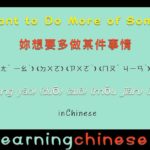(我)(用)(剪刀)❶(去剪)(蒲公英)(黃色)(的)(花) (ㄨㄛˇ)(ㄩㄥˋ)(ㄐㄧㄢˇ ㄉㄠ)(ㄑㄩˋ ㄐㄧㄢˇ)(ㄆㄨˊ ㄍㄨㄥ ㄧㄥ)(ㄏㄨㄤˊ ㄙㄜˋ)(ㄉㄜ˙)(ㄏㄨㄚ) (wǒ)(yòng)(jiǎn dāo)(qù jiǎn)(pú gōng yīng)(huáng sè)(de.)(huā) (I)(to use)(scissors, Continue Reading
Chinese Lesson Blurb: Using 卻 to Spotlight Contradiction
Politicians are masters of contradiction Politicians have a way of making rules for everyone else and exempting themselves. So it is no wonder that the common use of 卻 ㄑㄩㄝˋ (què) to indicate Continue Reading
Figure It Out 算出來,想出來 … in Chinese
The English phrase figure it out means to solve, to understand, to reason out This is consistent with the definitions of the word figure, which have to do with both to form or shape and Continue Reading
The Ups and Downs of 一 Yī in Chinese
The Chinese word and character 一 (yī) is one of the first that people learn, and for good reason. My dictionary devotes about 6 pages of words made with it. It not only means “one,” but is used as Continue Reading
You Want to Do More of Something 你想要多做某件事情 in Chinese
你想要多做某件事情 (你)(想要)(多)(做)(某件)(事情) (ㄋㄧˇ) (ㄒㄧㄤˇ ㄧㄠˋ) (ㄉㄨㄛ) (ㄗㄨㄛˋ) (ㄇㄡˇ ㄐㄧㄢˋ) (ㄕˋ ㄑㄧㄥˊ) (nǐ)(xiǎng yào)(duō)(zuò)(mǒu jiàn)(shì qíng) (you)(think to want)(more)(to do)(some + MW for affair)(affair, Continue Reading
得 is a pò yīn zì 是一個破音字
破音字 ㄆㄛˋ ㄧㄣ ㄗˋ are kind of like Chinese homonyms. In English, homonyms are words that sound the same, but are spelled differently (look different) and have different meanings. Examples: here and Continue Reading







